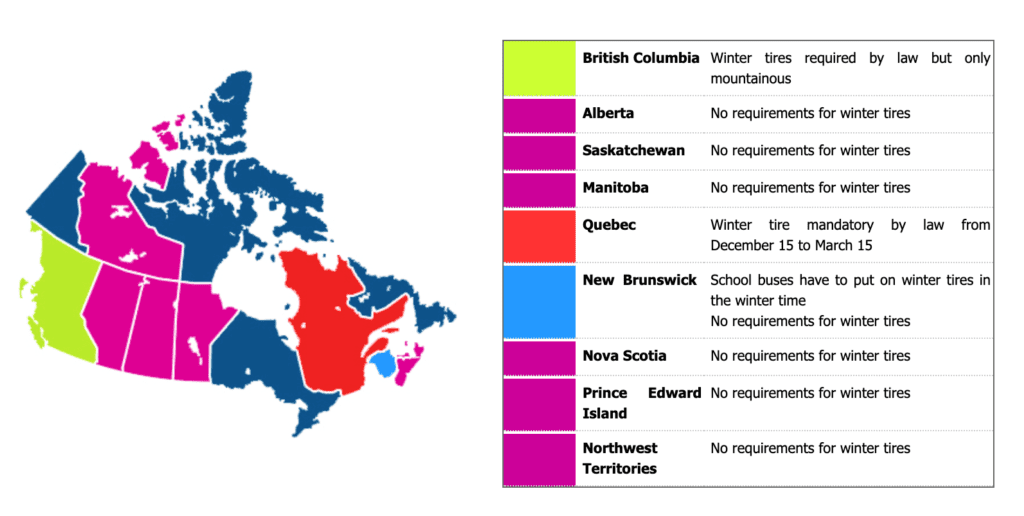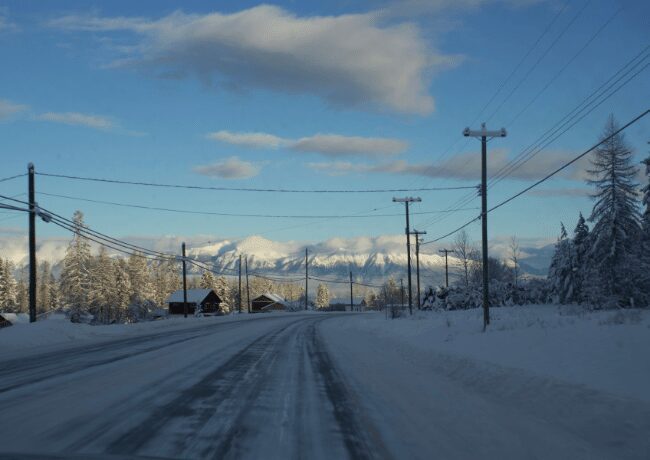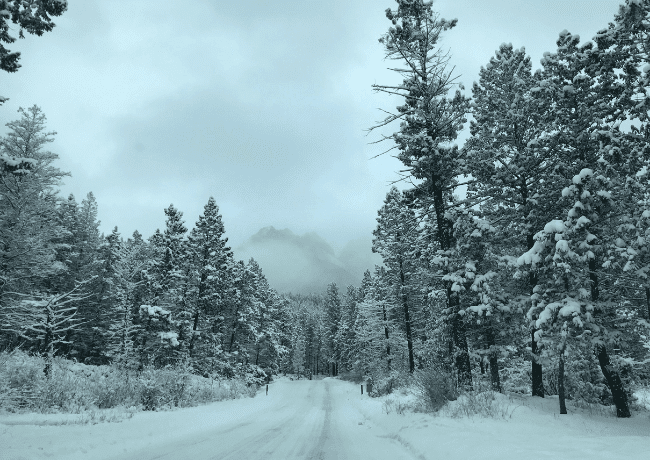Are you ready to hit the road this winter? Road trips are an excellent way to adventure near and far with the family. But there are a few winter travel tips to consider when road-tripping in the winter. That’s why we created this winter road trip planner resource for you.
In this post, you’ll find our
- winter travel tips,
- winter travel safety tips
Ready to meet your new favorite winter road trip planner? You can even download our winter travel tips checklist below.

Disclaimer: Just a heads up, this free article contains affiliate links. If you purchase after clicking one of these links, I may earn a small commission at no additional cost. Also, as an Amazon Associate, I earn from qualifying purchases. Your support helps me continue to provide helpful and free content for you.
1. Winterize Your Car
Get your car ready for winter by completing an in-depth check of your vehicle, or better still, pay a professional to do it.
- Check the amount of oil in the engine,
- Check all the lights work (internal and external)
- Make sure you have sufficient antifreeze and wiper fluid.
- Test your car heater and windscreen wiper blades.
- Consider changing your wiper blades for tougher all-weather blades.
If the car you are using for your winter road trip is a rental car, make sure you get assurances from the rental company that your car has been checked and prepared for your winter road trip.
❄️ Need some family winter road trips inspiration ❄️
The Best Family Winter Road Trip in the USA
Winter RV Camping in the Canadian Rockies
2. Check your tires
Check that your tires are roadworthy. The American Automobile Association recommends replacing tires with tread worn to 2/32 of an inch or less.
Make sure there’s enough pressure in your tires before you set off on your journey. It is important to check tire pressure regularly during your road trip as it drops quickly in cold temperatures.
And most importantly, make sure to change your tires for snow tires. Winter car snow tires provide excellent grip on snow-covered roads.
If you don’t have winter tires installed on your car, pack snow chains.
You can buy snow chairs in most retail stores with an auto part department, such as Canadian Tire or. Wal-Mart.
You’ll want to practice installing them before your winter road trip. You don’t want to attach snow chains for the first time in reduced light in a freezing blizzard!
Most road leading to mountain passes will have a safe turnout on the side of the road to safely install your snow chains.
3. Check winter driving regulations
You’ll want to check the winter driving regulations for the regions you are traveling through as well as at your destination, especially regarding winter tires.
Some local authorities set rules on the type of tires you can use on your car in winter, whilst regions require drivers to carry snow chains.
In the US and in Canada, there is no global regulation for all states and provinces when it comes to winter tire requirements. The regulations are different from region to region. The website Winter TPMS had good information on winter tire requirements for North America


It’s really important to know winter tire regulations, especially when renting a car. For example, Vancouver, Canada, doesn’t get much snow in the winter, and winter tires are not mandatory in the area.
When renting a car in the winter, the car will most likely have four seasons tires. But, if you plan to drive in the BC mountains and head to the Rockies, winter tires are required by law.
It’s thus essential to let the rental know and pay the extra for winter tires.

4. Purchase Road Assistance Membership
Roadside assistance is essential to any road trip, whether it’s during the summer or winter season.
If you aren’t a member of an organization, you can join the American Automobile Association (AAA) here or the Canada Roadside Assistance (CAA) here.
Both AAA and CAA offers road assistance all across Canada and USA. Plus, being a member also have other perks, such as discounted rates in a few hotel chains and gas station.
Alternatively, if the car you are using is a rental car, ensure it is covered by roadside assistance and that you know how to contact them.
5. Check the weather for your road trip
Check an up-to-date weather forecast on the National Weather Service before you travel.
Don’t forget to check the weather at your destination and the weather on the route. Tune in to local radio stations for updates on the route.
Up-to-date road information can also be found on Google.

6. Have a paper copy of the route and directions
Don’t get caught out by a dead mobile battery or lack of phone signal. Always travel with a paper map and a paper copy of your route and directions. Seek alternative routes in advance of your trip in case roads are closed or impassable.
Highlight on your map towns and villages along your route where you can seek shelter or accommodation in an emergency.
Create a copy of the route, destination details, and expected arrival time. Share this information with a trusted friend or family member. It is important that someone knows the route you have taken should you fail to arrive at your destination.
8. Make a note of emergency contacts
Add emergency numbers to your phone before the trip and duplicate them onto a paper copy.
Keep this copy somewhere accessible, such as in the glove box, and make sure everyone in your traveling party knows how and where to access it.
9. Prepare your emergency kit for winter travel
There are a few items that you should always have in your car when going on a winter road trip. From warm blankets to shovels and a first aid kit.

Winter travel tips for driving safely in the snow
When driving in the winter, you should take a few extra precautions to stay safe. Driving in winter storms is not always fun, but it’s always a probability when planning a cold-weather vacation.
10. Travel slower
Traveling slowly has two meanings when referring to a winter road trip.
Firstly, it means driving slower than you normally would. Road and weather conditions will be different to fair-weather driving and you will need to expect the unexpected.
Avoid sudden speed changes such as harsh braking, acceleration or steering as it increases your risk of skidding. Make sure you slow down well in advance of corners and bends.
Secondly, traveling slowly means adopting a slower form of travel.
When you start your winter road trip planning, make sure you don’t plan too much into your trip and into each day. Don’t try to match the driving distances and activity-filled days you can achieve on a summer road trip.
A packed itinerary with long driving distances will only add pressure and stress. It is impossible to drive the exact distances and visit the same number of attractions on a winter’s day as you can on a summer’s day.
Winter days are short and often dark and weather conditions can change quickly. Bad road conditions like fog, ice, black ice and winter storms will mean you have to drive more slowly than normal.
11. Leave a Good Distance Between Cars
It is essential to leave a greater-than-normal stopping distance between your car and other cars when driving in winter.
Tire grip is less efficient in winter conditions. Braking distances on snow-covered, icy winter roads are up to ten times higher than on dry summer roads.
12. Familiarize Yourself with Your Car
Whether you’re driving your own car or a rental car, make sure you familiarize yourself with how the car works, especially with technologies that you don’t use on a daily basis.
Know where the various lights are and which light to use for different situations.
Check if the vehicle you are using has an anti-lock brake system or not.
13. Know When it’s Time to Stop
If you feel it is unsafe to continue to your destination, then don’t. Find somewhere close by to stop safely.
It is better to waste a night of paid accommodation than to put your family in a dangerous situation.
For example, last December, we had this fantastic weekend planned. We stayed a few nights in Lake Louise (Banff National Park). The plan was to wake up early on one of the days and drive a section of the Icefields Parkway.
We started driving and probably 30 minutes onto the Icefields Parkway, we decided to turn around and do a hike nearby instead. A heavy winter storm was beginning to roll and there was lots of snow accumulation on the road.
It wasn’t enjoyable and it was stressful.
14. Keep Your Fuel Topped Up
Monitor your fuel gauge and top up your fuel whenever you can. Always keep it safe, and try not to go under a quarter tank (or even half a tank).
If there will be a long distance between garages, keep a full jerry can in your trunk.
Also, remember that some destinations have seasonal closures (especially in the winter time). So there may be fewer options for gas stations and restaurants. That is the case for example on the Icefields Parkway in the Canadian Rockies.
15. Keep Your Car Free of Snow
Clear your car of snow before setting off on each leg of your winter road trip. Make sure the front and rear headlights are snow-free to improve your view of the road as well as your visibility to other road users.
Don’t forget to keep your license plates clean and easy to read.
Clear all the snow off your roof to avoid it falling onto the windscreen and blocking your visibility whilst driving. It also prevents your roof from being blown onto the car’s windscreen behind you.
16. Allow for Flexibility in Your Winter Road Trip Planning
Plan your itinerary with flexibility in mind in case bad weather, road closures, and road conditions result in your trip plans having to change at the last minute.
Book accommodation that allows free cancellation or free date changes. Make free restaurant reservations and book tickets at attractions that will let you alter your dates without charge.
17. Brush Up on Your Winter Driving Skills
Driving in snow and on icy roads requires different skills to normal, fair-weather driving.
Make sure you know what to do in the situations that you may encounter in winter weather.
- Do you know how to spot black ice?
- What are the procedures you should follow if you get stuck on the road in a snow drift?
- Do you know what to do if you skid on the road?
If you cannot answer these questions, brush up on your winter driving skills before setting off on your winter adventure.
Why Take a Winter Road Trip?
Winter…. that time of year when we get freezing temperatures, bad weather, and short, dark days.
Why drive in those conditions?
Taking a road trip in winter surprisingly has its benefits:
- Attractions and touristy spots will probably be less crowded
- Restaurants will be less busy
- Accommodation will be at off-peak prices (unless of course you’re traveling to a ski area)
- Nothing beats the serenity of a snow-capped landscape, even in cold weather.
Final Thoughts: Winter Travel Tips
I hope you feel more prepared to hit the road this winter with your family for some epic road trips. It’s important to:
Be realistic in your winter road trip planning.
Plan shorter driving times and fewer attractions. There will always be something to do or see if you find that you have more time than you expected.
The AAA website has detailed and helpful articles on driving in winter. Check them out here. The government of Canada also has a great resource on winter travel tips.
Emilie is the founder of Love Life Abroad. She helps moms plan epic road trips and outdoor adventures with their families. Because who said adventuring had to stop once we have kids? She’s based in the Canadian Rockies and shares her love for the region as well as other unique places in Canada & USA. She works with tourism boards and outdoor brands to inspire families to experience new unique destinations and outdoor activities.
